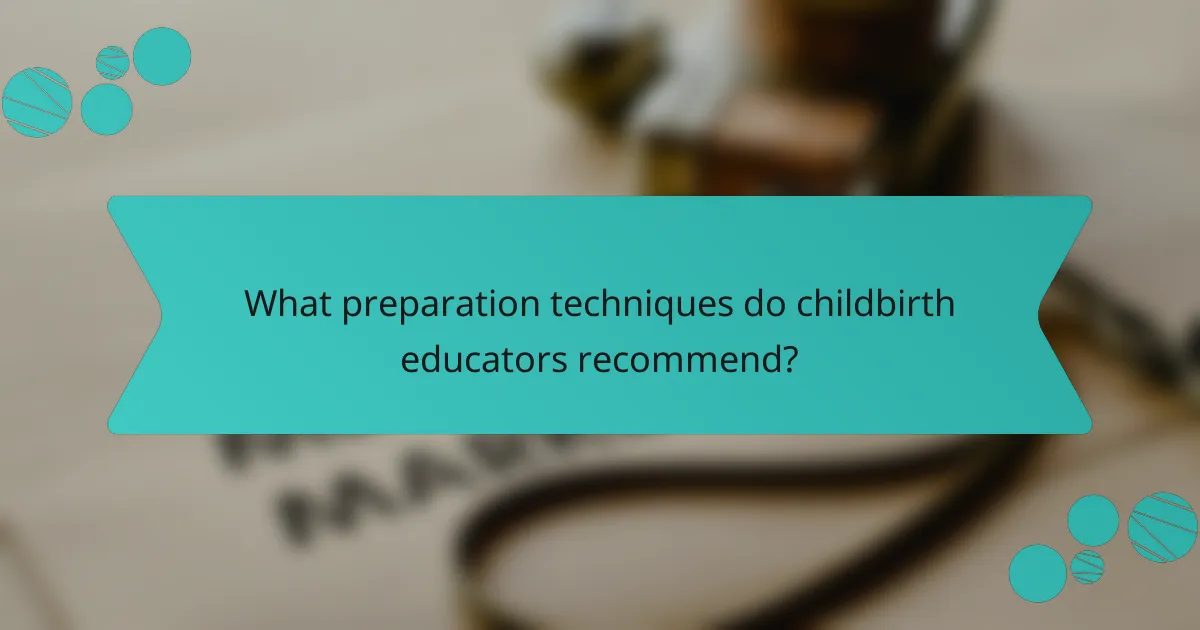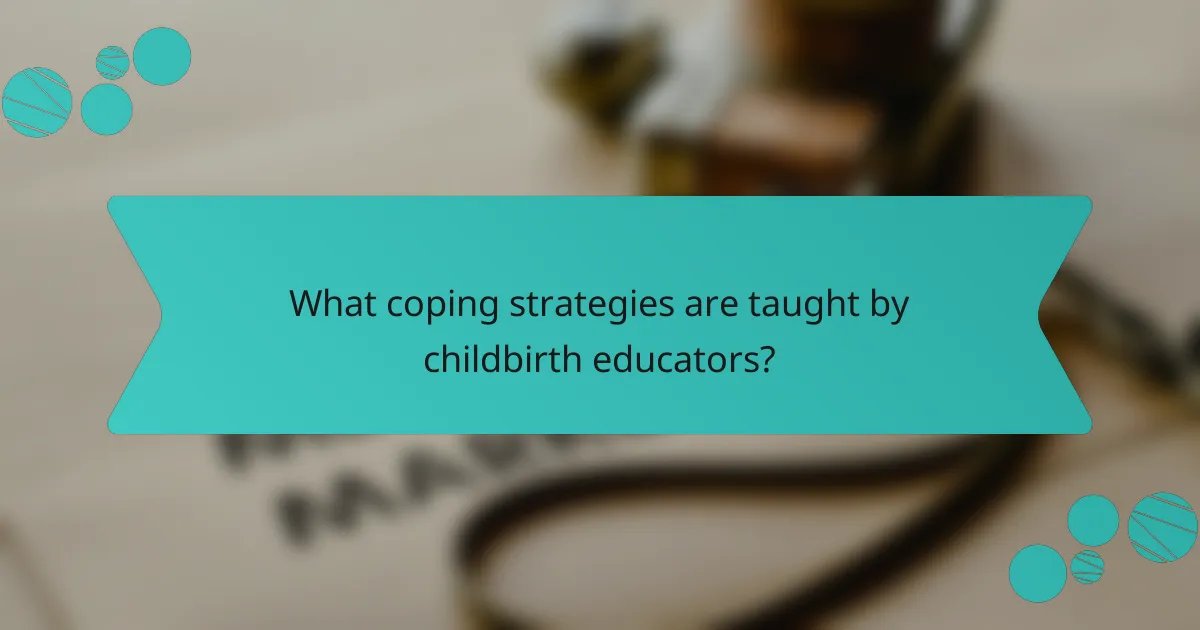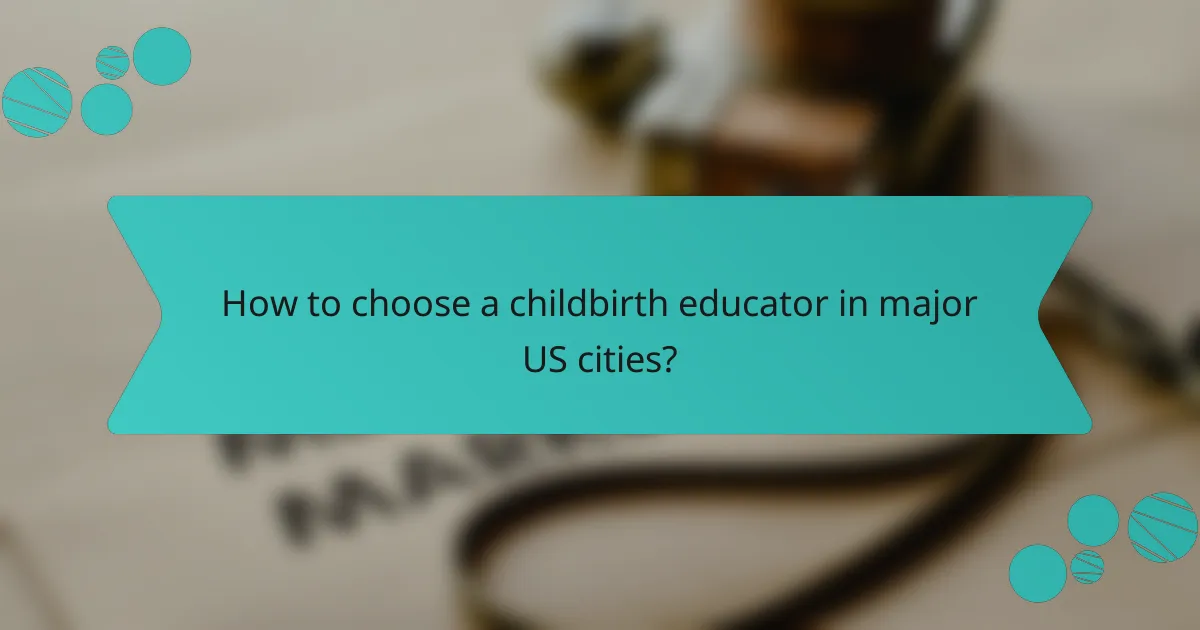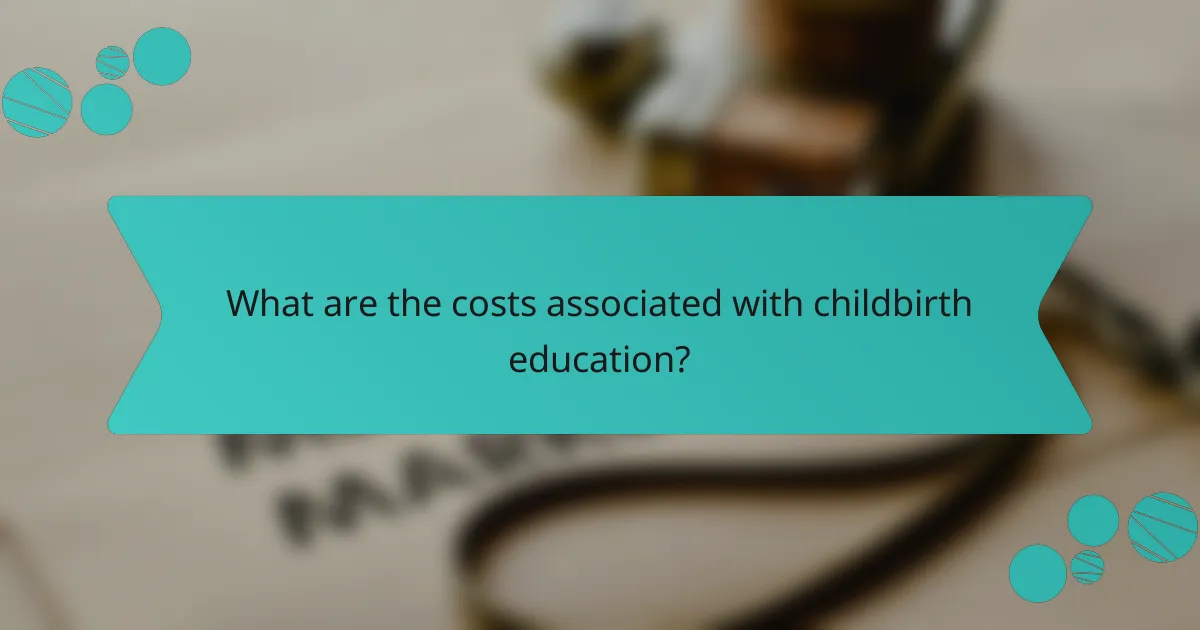Childbirth educators play a crucial role in empowering expectant parents by equipping them with essential knowledge and skills for a confident birthing experience. Through evidence-based practices and interactive learning, they provide preparation techniques and coping strategies that enhance both physical and emotional readiness for labor and delivery.

How can childbirth educators empower knowledge?
Childbirth educators empower knowledge by providing expectant parents with essential information and skills to navigate the birthing process confidently. They focus on evidence-based practices, interactive learning, and connecting families with community resources.
Evidence-based information
Childbirth educators deliver evidence-based information that helps parents understand the physiological and emotional aspects of labor and delivery. This includes discussing various birthing options, pain management techniques, and potential interventions.
Educators often reference guidelines from reputable organizations like the World Health Organization (WHO) or the American College of Obstetricians and Gynecologists (ACOG) to ensure the information is current and reliable. Parents can benefit from knowing the pros and cons of different approaches, such as epidurals versus natural pain relief methods.
Interactive workshops
Interactive workshops allow parents to engage actively with the material, enhancing retention and understanding. These sessions often include hands-on activities, role-playing scenarios, and group discussions that foster a supportive learning environment.
Workshops may cover topics like breathing techniques, labor positions, and newborn care, providing practical skills that parents can use during childbirth. Many educators also encourage questions and sharing personal experiences, which can deepen the learning experience.
Supportive community resources
Childbirth educators connect families with supportive community resources that can enhance their birthing experience. This includes local support groups, lactation consultants, and postpartum services, which can provide ongoing assistance after the baby arrives.
By facilitating access to these resources, educators help parents build a network of support that can alleviate stress and promote well-being. Parents should consider exploring local options, such as parenting classes or doulas, to complement their education and preparation for childbirth.

What preparation techniques do childbirth educators recommend?
Childbirth educators recommend various preparation techniques to empower expectant parents and enhance their birthing experience. These methods focus on physical and mental readiness, helping individuals manage labor and delivery effectively.
Breathing exercises
Breathing exercises are essential for managing pain and anxiety during labor. Techniques such as deep abdominal breathing and patterned breathing can help maintain focus and relaxation. Expectant parents should practice these exercises regularly to become familiar with them before labor begins.
Common breathing techniques include the “hee-hee-hoo” method, which involves short breaths followed by a longer exhale. This can help during contractions, allowing for better control over discomfort. Practicing in a calm environment can enhance effectiveness.
Visualization methods
Visualization methods involve creating mental images to promote relaxation and reduce stress during childbirth. Expectant parents can visualize a peaceful place or imagine the birth process going smoothly, which can help alleviate fear and anxiety.
To implement visualization, individuals can create a vision board or use guided imagery recordings. Regular practice can enhance the effectiveness of these techniques, making it easier to access calming imagery during labor.
Birth plan development
Developing a birth plan is a proactive step that outlines preferences for labor and delivery. This document can include choices about pain management, positions for labor, and who will be present during the birth. It serves as a communication tool between parents and healthcare providers.
When creating a birth plan, it’s important to remain flexible, as circumstances may change during labor. Parents should discuss their plan with their healthcare team to ensure everyone is on the same page. A well-thought-out birth plan can empower parents and enhance their confidence during the birthing process.

What coping strategies are taught by childbirth educators?
Childbirth educators teach various coping strategies to help expectant parents manage labor and delivery effectively. These strategies focus on physical and emotional techniques that empower individuals, enhance comfort, and promote a positive birthing experience.
Relaxation techniques
Relaxation techniques are essential for reducing tension and anxiety during labor. Methods such as deep breathing, visualization, and progressive muscle relaxation can help individuals stay calm and focused. Practicing these techniques beforehand can make them more effective during labor.
Common approaches include guided imagery, where a person visualizes a peaceful scene, and rhythmic breathing, which can help maintain a steady pace during contractions. Expectant parents can create a personal relaxation plan that incorporates their favorite methods.
Continuous labor support
Continuous labor support involves having a dedicated support person, such as a partner, doula, or childbirth educator, present throughout the labor process. This support can significantly enhance comfort and reduce the perception of pain. Studies suggest that continuous support can lead to shorter labors and lower rates of interventions.
Choosing the right support person is crucial; they should be familiar with the birthing plan and able to provide emotional and physical assistance. Effective support includes offering encouragement, helping with positioning, and providing comfort measures like massage or warm compresses.
Mindfulness practices
Mindfulness practices help individuals stay present and engaged during labor, reducing stress and enhancing coping abilities. Techniques such as meditation, body scanning, and mindful breathing can cultivate awareness and acceptance of the birthing experience.
Incorporating mindfulness into childbirth preparation can be beneficial. Expectant parents might consider attending classes that focus on mindfulness or practicing at home through guided sessions. This approach encourages a calm mindset, allowing individuals to respond to labor’s challenges with greater resilience.

How to choose a childbirth educator in major US cities?
Choosing a childbirth educator in major US cities involves evaluating their qualifications, teaching style, and client feedback. Consider factors such as location, availability, and the specific needs of your birth plan to find the right fit.
Qualifications and certifications
When selecting a childbirth educator, check their qualifications and certifications. Look for credentials from recognized organizations such as the International Childbirth Education Association (ICEA) or Lamaze International, which indicate a standard of training and knowledge.
Additionally, inquire about their experience in teaching childbirth classes. Educators with several years of experience may offer more practical insights and coping strategies based on real-world scenarios.
Teaching style and philosophy
Each childbirth educator has a unique teaching style and philosophy that can significantly impact your learning experience. Some may focus on evidence-based practices, while others might emphasize holistic approaches or emotional support during labor.
It’s beneficial to attend a trial class or read about their teaching methods online. This can help you determine if their approach aligns with your preferences and comfort level regarding childbirth.
Client testimonials
Client testimonials provide valuable insights into the effectiveness of a childbirth educator. Look for reviews on their website or social media pages, as well as third-party platforms where clients share their experiences.
Pay attention to feedback regarding the educator’s ability to create a supportive environment, their responsiveness to questions, and the practical skills taught. Positive testimonials can indicate a strong educator who empowers clients through knowledge and preparation.

What are the benefits of childbirth education classes?
Childbirth education classes provide essential knowledge and skills that empower expectant parents, enhancing their confidence and preparation for labor and delivery. These classes cover various topics, including coping strategies and partner involvement, leading to a more positive birth experience.
Increased confidence
Attending childbirth education classes significantly boosts parents’ confidence by equipping them with information about the birthing process. Understanding what to expect during labor helps alleviate fears and uncertainties, allowing parents to approach childbirth with a more positive mindset.
Classes often include practical exercises, such as breathing techniques and relaxation methods, which further enhance confidence. Parents can practice these skills, making them feel more prepared and capable when the time comes for delivery.
Better birth outcomes
Research indicates that parents who participate in childbirth education classes often experience improved birth outcomes. This can include shorter labor times, reduced rates of interventions like cesarean sections, and higher satisfaction with the overall birthing experience.
By learning about pain management options and the stages of labor, parents can make informed decisions that align with their birth plan, ultimately leading to a more favorable outcome for both mother and baby.
Enhanced partner involvement
Childbirth education classes foster greater involvement from partners, helping them understand their role during labor and delivery. This shared knowledge allows partners to provide better emotional and physical support, which can be crucial during the birthing process.
Classes often encourage partners to participate in hands-on activities, such as practicing comfort measures and learning how to advocate for the birthing person’s needs. This collaborative approach strengthens the bond between partners and enhances the overall childbirth experience.

What are the costs associated with childbirth education?
The costs of childbirth education can vary widely based on the type of classes, location, and instructor experience. Typically, expectant parents can expect to pay anywhere from $50 to several hundred dollars for comprehensive courses that cover various aspects of childbirth preparation.
Types of childbirth education classes
Childbirth education classes come in various formats, including in-person sessions, online courses, and private consultations. In-person classes often provide hands-on practice and direct interaction with instructors, while online options offer flexibility and convenience. Private sessions can be tailored to specific needs but may come at a higher cost.
Average costs
On average, group classes may range from $75 to $300 for a series of sessions, while private classes can cost between $100 and $500 per session. Some hospitals offer free or low-cost classes as part of their maternity services, so it’s worth checking with local healthcare providers.
Insurance coverage
Many health insurance plans may cover some or all of the costs associated with childbirth education classes. It’s advisable to contact your insurance provider to understand your benefits and any requirements for reimbursement. Some plans may require pre-approval or a referral from a healthcare provider.
Financial assistance options
For those facing financial constraints, various organizations and community programs may offer scholarships or sliding scale fees for childbirth education classes. Local non-profits, hospitals, and community centers often have resources to help expectant parents access these educational opportunities.
